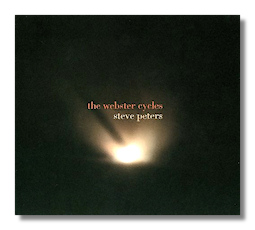
The Internet's Premier Classical Music Source
Related Links
- Peters Reviews
- Latest Reviews
- More Reviews
-
By Composer
-
Collections
DVD & Blu-ray
Books
Concert Reviews
Articles/Interviews
Software
Audio
Search Amazon
Recommended Links
Site News
 CD Review
CD Review
Steve Peters

The Webster Cycles
J.A. Deane, trombones
Cold Blue Music CB0026 DDD 29:45
Steve Peters (b. 1959) is a Seattle-based composer (in his blog, he identifies himself as a "noisemaker") who makes "music and sound for various contexts and occasions" – a vague enough self-description, but I think I know what he is getting at. He has created sound installations for various museums and other public spaces, and many of them are based, somewhat paradoxically, on the sound of "silence" – a concept that owes something to John Cage, and that might have interested Simon and Garfunkel! (Joking, joking.) In other words, Peters sometimes collects the quietest sounds – such as those present in an empty or "silent" room – and uses them as the basis for sound installations.
Compared to some of his other works, The Webster Cycle is deafening, but you won't need your earplugs for it. Peters structured it on all of the words in the dictionary that use only the letters A through G (hmm, I wonder how many there are?), arranged and played ("bag" is equivalent to B-A-G, for example) in alphabetical order. There is an improvisational element as well, because although each "word" is played for the length of one long breath, the performer decides how long to spend on each "letter"/note, and can change dynamics and timbre at will. Also, The Webster Cycle can be played by "any combination of winds or voices." Here, it is played by six over-dubbed trombones in what sounds like a very resonant space. This obviously suggests the work of trombonist Stuart Dempster, who is famous for having played his instrument in cisterns and in the Great Abbey of Clement VI. Sure enough, this realization of The Webster Cycles is dedicated to Dempster.
The Webster Cycles is quiet but it is not merely peaceful or pretty. The overlapping trombone notes form tendrils and clouds of sound that are interesting enough to invite active listening. Yes, atmosphere is paramount in this work, but can't one say the same about impressionism? On occasion, a whiff of the blues or jazz emerges out of the texture, only to merge back into it. What Peters and trombonist J.A. Deane have created here is a space into which the listener can enter, and they have done it in such a way that the space even seems to take on three-dimensional qualities. Mysterious, but neither threatening nor anodyne, The Webster Cycles is music you can spend time with for hours on end. J.A. Deane has Peters' blessings and admiration, and I second the motion. The engineering gets out of Peters' and Deane's way.
Although there is less than a half-hour of music on this CD, the list price is $10.98, so no complaints!
Copyright © 2008, Ray Tuttle




















